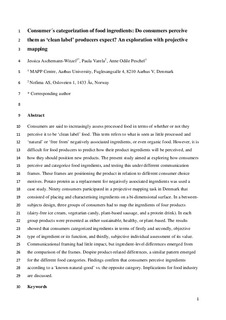| dc.contributor.author | Aschemann-Witzel, Jessica | |
| dc.contributor.author | Varela, Paula | |
| dc.contributor.author | Peschel, A.O. | |
| dc.date.accessioned | 2019-10-24T11:47:50Z | |
| dc.date.available | 2019-10-24T11:47:50Z | |
| dc.date.created | 2018-09-25T08:28:20Z | |
| dc.date.issued | 2019 | |
| dc.identifier.citation | Food Quality and Preference. 2019, 71 117-128. | nb_NO |
| dc.identifier.issn | 0950-3293 | |
| dc.identifier.uri | http://hdl.handle.net/11250/2624158 | |
| dc.description.abstract | Consumers are said to increasingly assess processed food in terms of whether or not they perceive it to be ‘clean label’ food. This term refers to what is seen as little processed and ‘natural’ or ‘free from’ negatively associated ingredients. However, it is difficult for food producers to predict how the product ingredients will be perceived, and how they should position new products. The present study aimed at exploring how consumers perceive and categorize food ingredients, and testing this under different communication frames. These frames are positioning the product in relation to different consumer choice motives. Potato protein as a replacement for negatively associated ingredients was used a case study. Ninety consumers participated in a projective mapping task in Denmark that consisted of placing and characterising ingredients on a bi-dimensional surface. In a between-subjects design, three groups of consumers had to map the ingredients of four products (dairy-free ice cream, vegetarian candy, plant-based sausage, and a protein drink). In each group products were presented as either sustainable, healthy, or plant-based. The results showed that consumers categorized ingredients in terms of firstly and secondly, objective type of ingredient or its function, and thirdly, subjective individual assessment of its value. Communicational framing had little impact, but ingredient-level differences emerged from the comparison of the frames. Despite product-related differences, a similar pattern emerged for the different food categories. Findings confirm that consumers perceive ingredients according to a ‘known-natural-good’ vs. the opposite category. Implications for food industry are discussed. | |
| dc.language.iso | eng | nb_NO |
| dc.title | Consumer’s categorization of food ingredients: Do consumers perceive them as ‘clean label’ producers expect? An exploration with projective mapping | nb_NO |
| dc.type | Journal article | nb_NO |
| dc.type | Peer reviewed | nb_NO |
| dc.description.version | acceptedVersion | |
| dc.description.version | submittedVersion | |
| dc.source.pagenumber | 117-128 | nb_NO |
| dc.source.volume | 71 | nb_NO |
| dc.source.journal | Food Quality and Preference | nb_NO |
| dc.identifier.doi | 10.1016/j.foodqual.2018.06.003 | |
| dc.identifier.cristin | 1613175 | |
| dc.relation.project | Nofima AS: 11946 | nb_NO |
| dc.relation.project | Norges forskningsråd: 262308 | nb_NO |
| dc.relation.project | Nofima AS: 201702 | nb_NO |
| cristin.unitcode | 7543,3,3,0 | |
| cristin.unitname | Sensorikk, forbruker og innovasjon | |
| cristin.ispublished | true | |
| cristin.fulltext | postprint | |
| cristin.fulltext | preprint | |
| cristin.qualitycode | 1 | |
